Going with the Flow: Geology’s Fall Departmental Field Trip 2022
Last weekend the Geology Department set forth on our Fall departmental trip for a geological field trip down the James River in canoes. The late summer weather was glorious, and the James River’s flow was just right– not too high and not too low.
On Friday evening, our crew of 22 camped along the James River floodplain at Hatton Ferry. While marshmallows toasted on the campfire, we discussed the origin of the floodplain upon which our tents were pitched. With the James River’s waters well within the stream banks, it was a fine evening for camping on the floodplain.
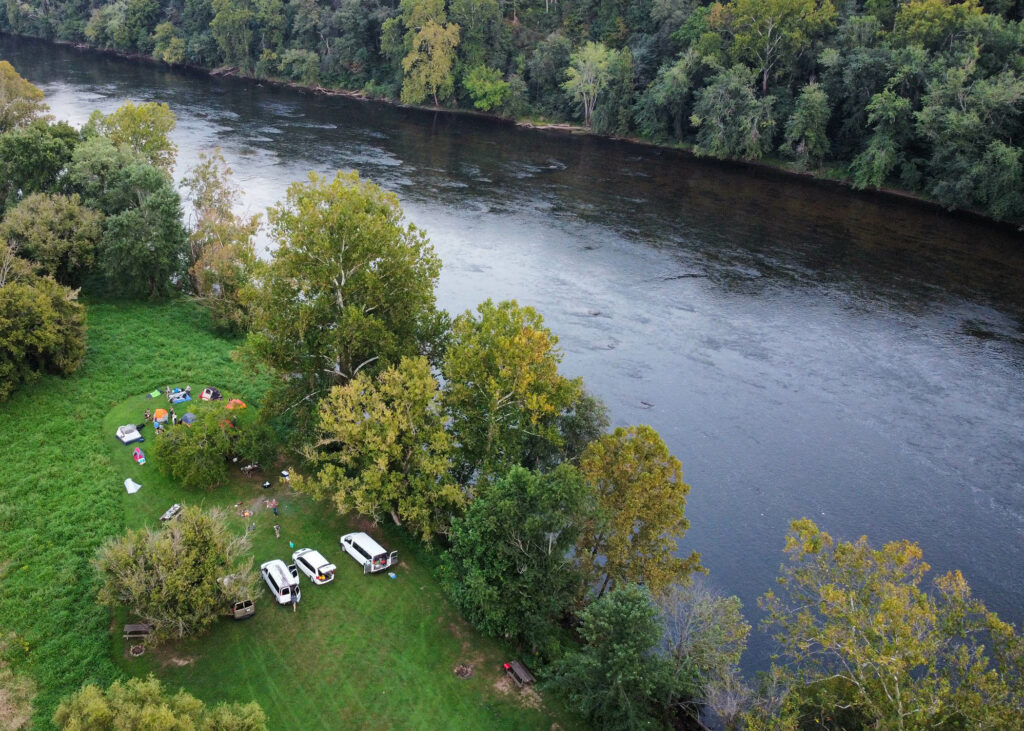
Aerial image of our campsite located on the James River floodplain at Hatton Ferry, Virginia. (photo by Jim Kaste)
Early Saturday, we piled into the outfitter’s magic school bus and were shuttled upstream to the put-in at Howardsville. By 9 a.m., we were underway and, soon thereafter, heading at full steam down the James River. As I’ve written in previous posts, the canoe is the perfect craft for navigating flowing waters such as the James. Our crew consisted of ambitious paddlers and we quickly arrived at our first outcrop in mid-river.
At an outcrop called the Alligator, as its long and low profile resembles a ~100-meter partially submerged alligator, we discussed the depositional environment of this clastic sedimentary rock deposited ~220 million years ago in a newly formed rift basin.
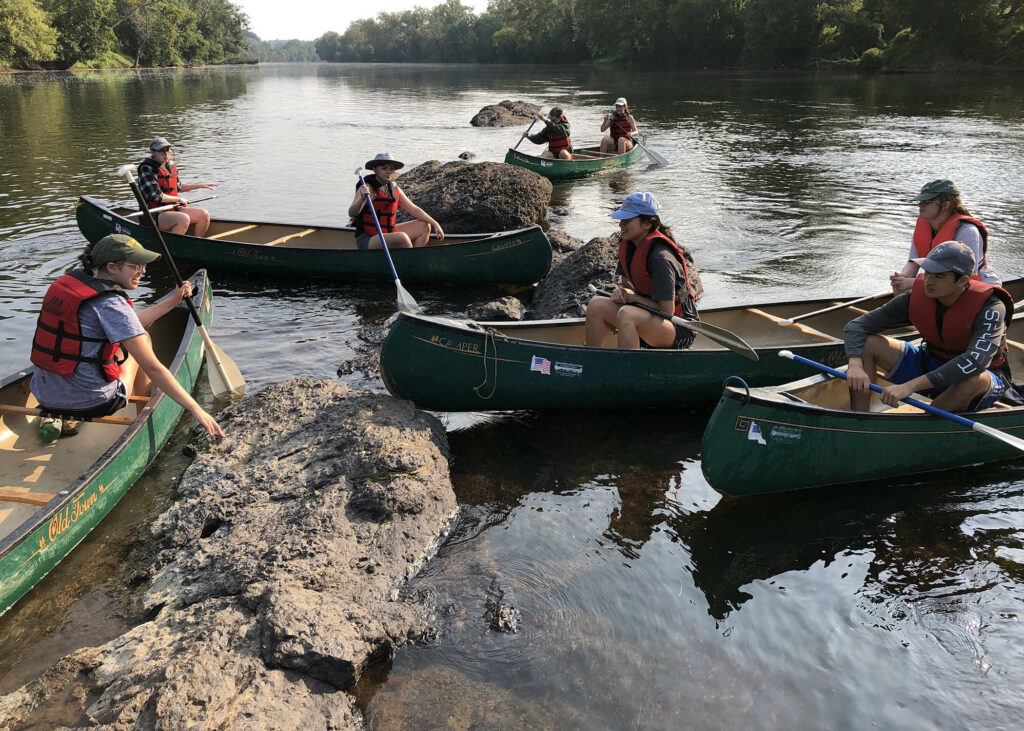
Arrival at the Alligator, an exposure of conglomerate/breccia, a sedimentary rock cropping out in the Scottsville Basin, an ancient rift basin that was a forerunner to the Atlantic Ocean during the Triassic.
At other locations, we estimated the James River’s flow rate (discharge), measured the river waters’ conductivity and sediment load (both quite low), and mused on the residence time of pebbles on the bottom of the channel.
From a paddling perspective, the highlights of the trip are three rapids which throw up some modest whitewater and present challenges for proceeding downstream completely dry. On this trip, we had 11 canoes, and our collective scorecard for successfully navigating the three rapids was 32/33 — not bad. Unfortunately, the one calamity involved an overturned canoe and the cooler with lunch supplies going in the river. Lunch was recovered, but the humus-spreading knives went to the bottom of the James.
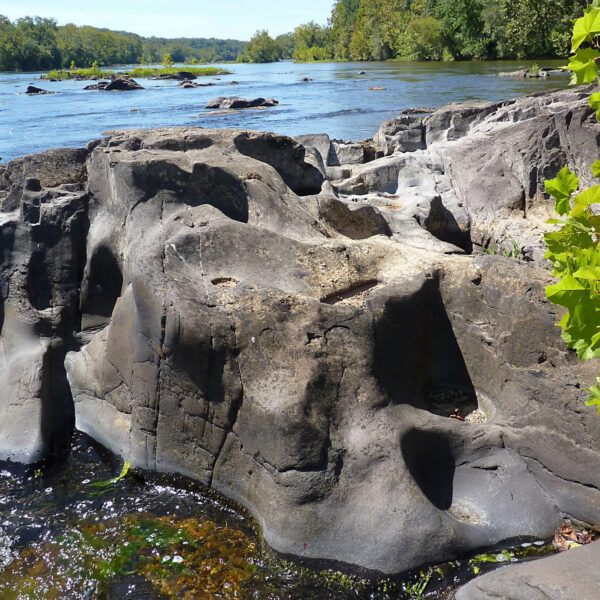
A fluted outcrop of diabase with potholes along the James River in central Virginia. Fluvial erosion/abrasion of the bedrock created these features.
The three sets of rapids are all developed where the James River crosses diabase dikes. Diabase intruded into the older sedimentary rocks of the Scottville Basin, with these dikes likely serving as conduits for deep-seated magma to be erupted to the surface. Diabase is a hard and durable rock. Smack a diabase sample with a rock hammer and it will produce a distinctive ring and sparks, but even a strong blow does not always break the rock. Along this stretch of the James, fluted/scalloped surfaces and even potholes are common on the diabase outcrops–these are distinctive erosional features that develop during floods as water-washed sediment abrades and sculpts tough bedrock.
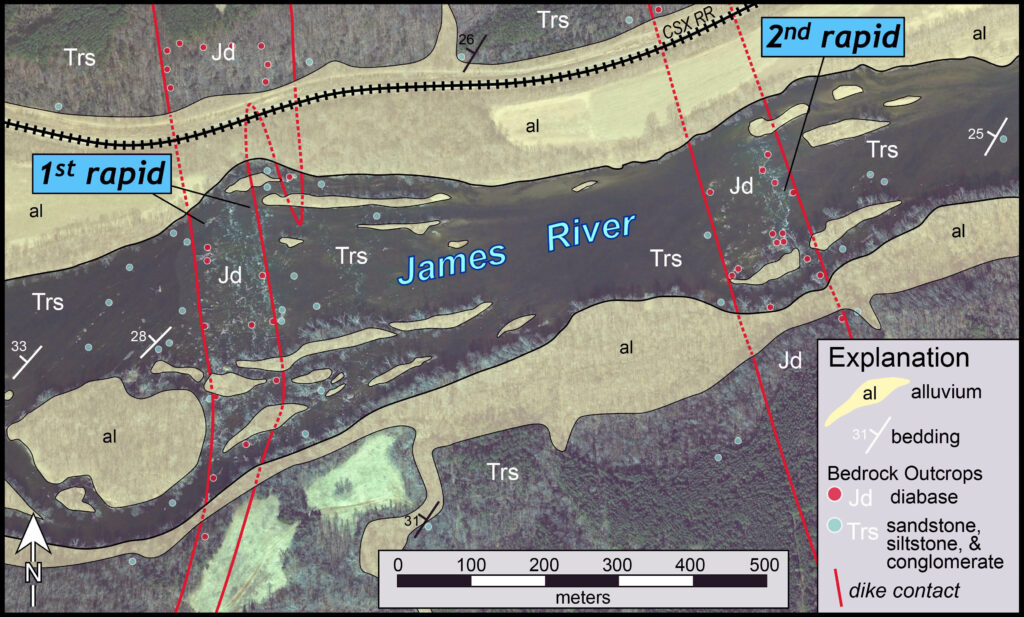
A geologic map of the Goosby Islands area along the James River in central Virginia. The colored dots are outcrops. Two north to northwest-trending diabase dikes (Jd) cross cut the older Triassic sedimentary rocks (Trs). Class I-II rapids are developed on the diabase outcrops.
From a geomorphologist’s perspective, the rapids are knickpoints. Effectively, stretches of the channel where the stream gradient is noticeably steeper than both up and down stream. What causes knickpoints? It’s not unusual for knickpoints to develop on harder rocks, because, to erode harder rocks, a stream’s gradient must increase, thereby creating faster flows and more power.
After lunch as we finished our discussion of knickpoints, I cheekily asked whether these are stationary or migratory knickpoints. In the post-lunch torpor, nobody much wanted to answer my question and some students took to riding partially submerged logs as a means of escape. Learning has its limits :).
But from the comfort of my office, I’ll ask the question again: are the rapids along this stretch of the James River stationary or migratory knickpoints? Why not post a comment and enrich the debate!
From my perspective, the departmental trip was a great success. These trips build community by growing camaraderie amongst both students and faculty. William & Mary is an institution that values experiential learning and our going with the flow down the James River is a perfect example of how learning and fun can be coupled together.
Curious to see more from our adventure? If so, then checkout these photos and another video from the trip.
Comments are currently closed. Comments are closed on all posts older than one year, and for those in our archive.

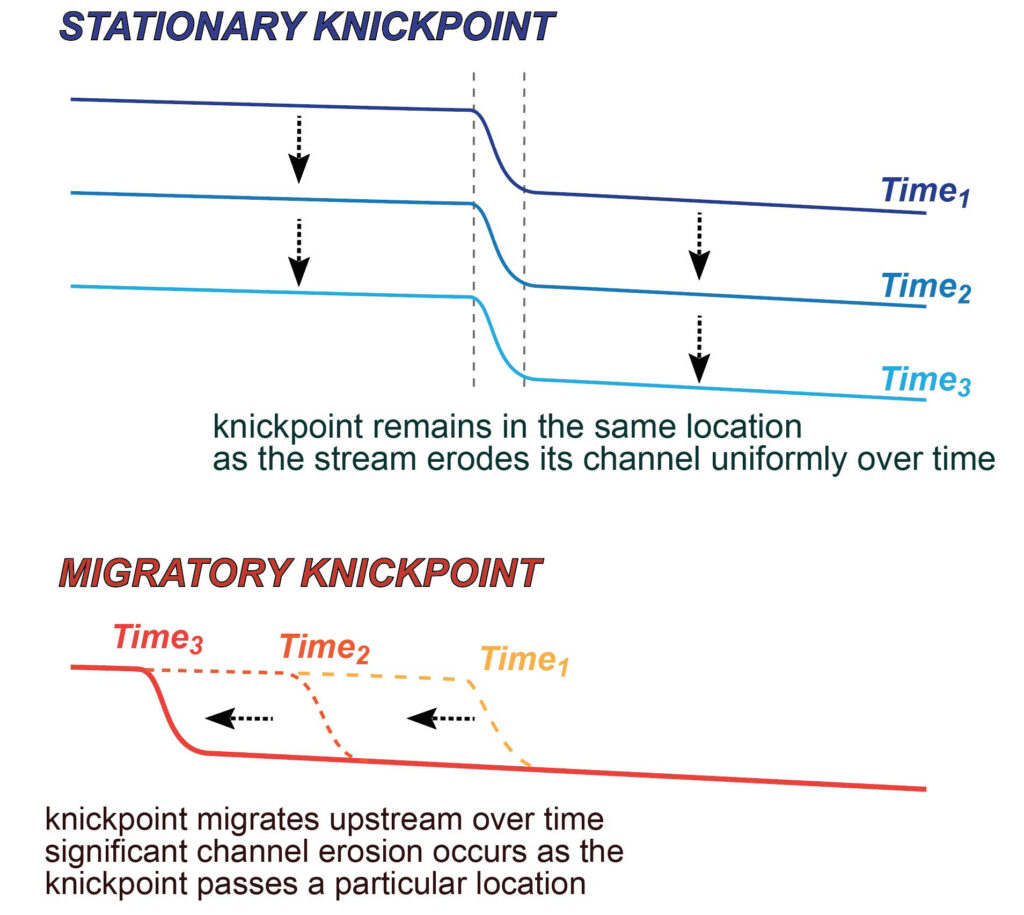
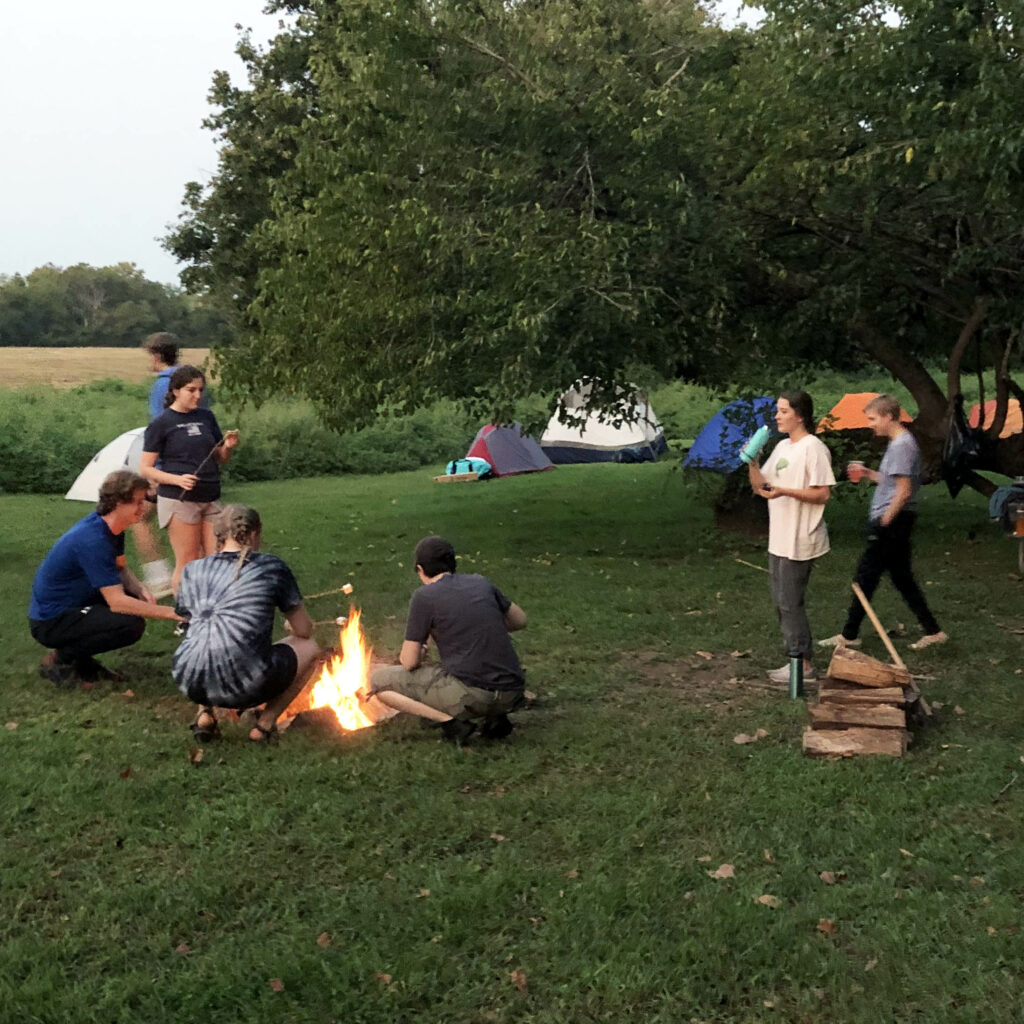
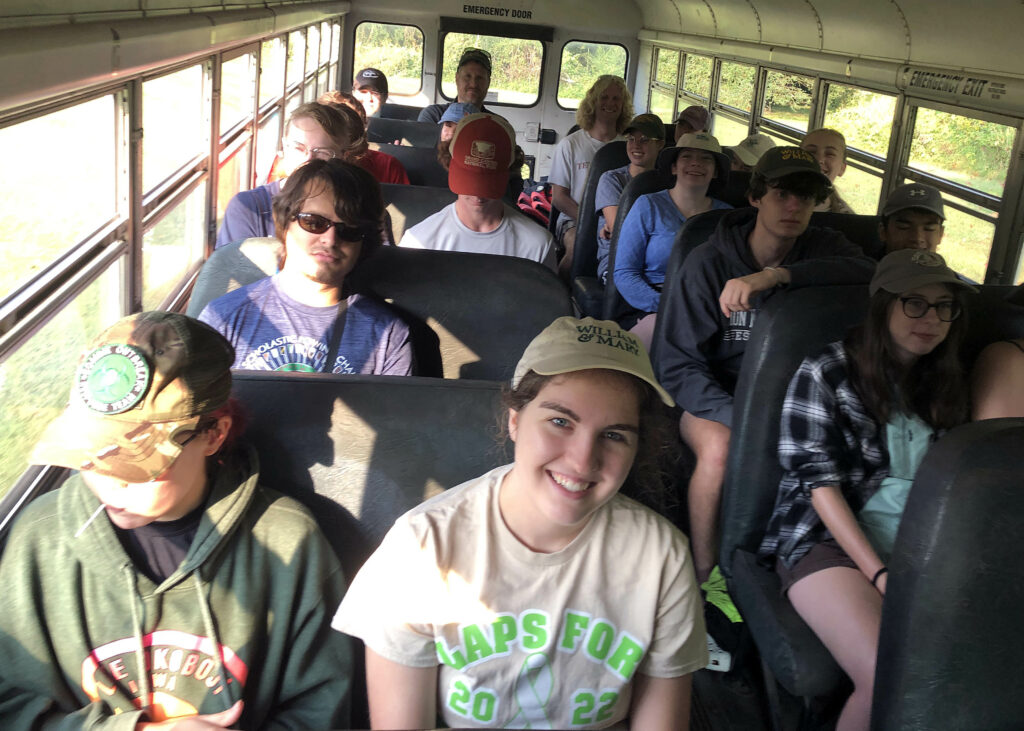
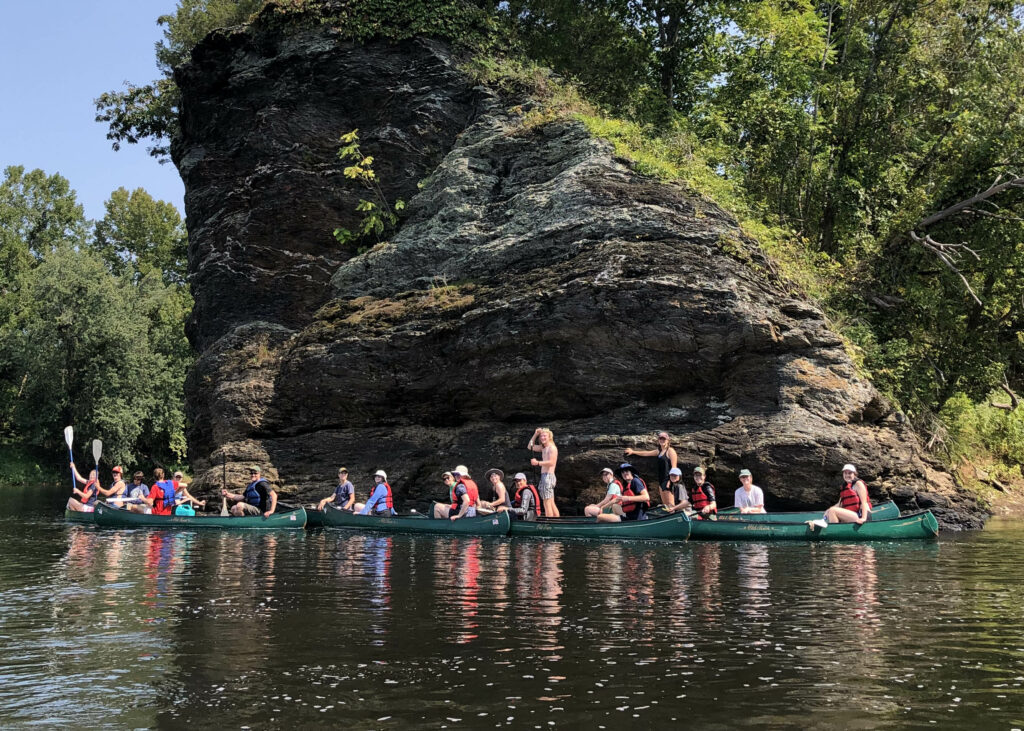

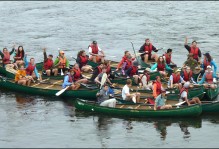

I don’t think the knickpoint is a mobile knickpoint because of the drop in the video. After doing some research, I read that moving knickpoints can have a slight slope over time rather than a dramatic drop and I am just making this assumption based on the video. I think additionally the type of rock might make it more difficult to have a moving knickpoint.
I agree with Bibiana in that the knickpoint is migratory rather than stationary. I feel like the stream would move the sediment, thus moving the knickpoint.
I think they are stationary knickpoints because they occur due to the diabase outcrops. It wouldn’t make sense for them to migrate because the intrusions causing the rapids are not going to move up stream.
Like Anna and Bibiana, I believe the knickpoints shown in the video are stationary. The rapids occur along diabase outcrops, indicating a difference in erosion rates that may be the source of the knickpoints. As the diabase is an intrusive formation, it wouldn’t shift laterally over time — erosion would merely expose more of the dike downwards.
I think that they are stationary knickpoints because at the knickpoints there are diabase intrusions which is a much harder rock compared to the surrounding sedimentary rock. I feel like the knickpoints would be migratory if the material upstream was made from material of similar hardness to the material at the knickpoint so the knickpoint could migrate upstream.
These are likely stationary knickpoints, because the hard diabase intrusions are a unit made up of a larger melange with resistant lithology.
I believe the knickpoints are stationary because they come from the diabase intrusions, which are durable as is mentioned in the blog, so are more likely to stay in the same place and be slowly eroded down rather than migrating.
I think the knickpoints are stationary because they formed from diabase intrusions that are resistant and stay in the same place rather than eroded and moved.
This was such a fun field trip! I especially loved the rapids over the Diabase knickpoints — dare I say they are stationary!
It seems to me that the knickpoint forming these rapids is stationary. This is because the rapids are likely formed from diabase intrusions and it would make sense for the surrounding material to strode at a different rate creating the Knick point and thus the rapids. As a result, it doesn’t shift up or down river, but stays in place.
I think these are stationary knickpoints due to the underlying geology of the channel. The knickpoints being formed over the hard diabase makes me think that it would be difficult to erode away and, therefore, form a stationary knickpoint. And if it took Chuck 10 minutes to get a sample of diabase, there’s no way a stream could erode it away!
Really cool blog post, Chuck! In my opinion (that seems to be shared by others), these knickpoints seem to be stationary! These knickpoints occur over diabase outcrops, and that’s quite different from the sedimentary surrounding rocks! It’d take longer for them to erode. These intrusions wouldn’t be dealing with erosion in the same way that the sediments of the James River would!
I believe that the knickpoints are stationary because they are formed from diabese intrusions. I think this is stationary because the diabese would have stayed in the same place and eroded over time rather than migrating upstream.
I think the knickpoints are stationary because they formed on rocks that are harder/harder to erode- meaning the stream gradient would have to continue to increase every year to make the points migrate. You could probably test this by tracking stream data to see how the flow changes year to year.
I feel that it’s a stationary knickpoint. What created these knick points was the hard durable disbase dikes. It would be a bit difficult to move a knickpoint unless the underlying material wasn’t as durable in my opinion.
I think the nickpoints along this section of the James River are stationary ones, as they are marked / created by diabase dikes that are *less* easily eroded comparative to the surrounding sedimentary rocks. That means the nickpoints aren’t going to move upstream since the dikes don’t extend particularly far, but rather just erode downward very slowly.
I would say these knickpoints are stationary! Based on the Diabase intrusions/underlying geology, as well as the outline of the knickpoint slope shown in the video, the knickpoint appears to be in the same location over time. What a cool knickpoint!
The diabase that the Knick points are cut into would be difficult to create a migratory system. I believe that is it stationary. The diagram of the slope seems to support this idea.
‘‘Twas a lovely trip and a beautiful day for a canoeing adventure. As for these knickpoints, they seem quite formidable and perhaps even stationary due to the resistant diabase material. Over time this landscape may erode downward, but I believe I share my classmates thoughts that these knickpoints do not, in fact, migrate.
I also think that the knickpoint is stationary because of the resistant diabase intrusion. The unit was slowly eroded downward, though it might have been a migratory knickpoint if softer rock was lying below the stream. This field trip looks like a blast!
I agree with the others about the knickpoint being stationary. The diabase rock beneath the knickpoint would make it difficult for the knickpoint to erode horizontally.
Great post, Chuck! I believe that the knickpoints are currently stationary due to the underlying bedrock. Diabase is more resistant to erosion than the surrounding sedimentary rocks. Although, I also believe it is possible that the knickpoint zone could have experienced times of migration in the past.
I also believe these knickpoints are stationary due to the diabase. This diabase is much more resistant than the surrounding sedimentary rocks. I would think those sedimentary rocks would erode before the diabase does, creating this knickpoint. This seems like a super fun field trip!
I agree with the stationary knickpoint group. Diabase was found at these knickpoints, and its increased resistance to weathering has kept the location relatively in place. I’m sad that I missed this trip, but it’s great that the Department could organize this to bring so many together to learn more about geology!
I would say that the Knick points are stationary given that they occur at stationary diabase dikes.
What a great trip! That video is pretty great too, I wonder who made it. To answer this debate-inducing question: The knickpoint is likely stationary as the diabase dikes mark the locations. These rocks are typically harder to erode than the surrounding bedrock, meaning they will not move, but instead, the elevation will lower over time.
Glad to see that the weather was nice when everyone went on the trip! As for the debate of if this is a stationary or migratory knickpoint, I am going to have to say it is a stationary knickpoint. After looking at the image of the fluted outcrop of diabase, anyone could see how the bedrock has eroded over time, and I feel like if the river was dammed off to see what the underlying geology looked like it would be the more bedrock that had been carved overtime. Thus, making it a stationary knickpoint
When I initially read through this blogpost, I believed that the knickpoints on the James River were migratory, as I thought that even the erosion-resistant diabase rocks would have more water hitting them more frequently in a stream that completely covers them rather than a waterfall where not all of the water might be able to hit the rocks as frequently, thus resulting in quicker, although still gradual, erosion over time. However, after reading through the blogpost again, I now believe that these knickpoints are stationary, as the more erosion-resistant rock would be more likely to be eroded downward rather than being shifted forward or backward in position through erosion due to differential erosion rates between the erosion-resistant diabase and the erosion-susceptible bedrock. This would mean that, although the reliefs of the knickpoints might be increased, their position would remain stationary.
I think these knickpoints are stationary because the diabase intrusions appear to be the reason the knickpoints formed where they did in the river. It would not make sense for the knickpoints to move because the rock intrusion is not going to move upstream. Additionally, the diabase is a sturdy rock, so any erosion that would move the knickpoint upstream would be resisted by the diabase.
Looks like a great field trip! I don’t think my opinion is adding much spice to this debate because like many of my classmates, I think that the knickpoints are stationary. In a map posted in the vlog, it shows the knickpoints being where diabase is the underlying bedrock. The diabase is less likely to be eroded away and create a migratory knickpoint that moves upstream. That is why I think that those knickpoints are stationary!
I’m thinking a stationary knickpoint because the sedimentary rock would erode faster than the diabase so the river would have to flow faster over the diabase to erode it, forming a knickpoint. Since the diabase is harder, it’s also less likely to erode and collapse at the base.
I believe that this is a stationary knickpoint, as the knickpoint itself is focused on outcrops of diabase and surrounded by softer sedimentary materials. While both these materials are eroding over time, the diabase outcrops erode more slowly, but this also limits the downwards erosion of the material upstream from the diabase outcrop until the diabase itself has eroded.
I think the two knick points are one of each. The first rapid has a curve profile looking from overhead. This tells me it is moving laterally. The 2nd rapid is a straight line os if it is moving, its doing so in a way that cant be seen by a simple overhead view. I think the 2nd one is a stationary knickpoint
I agree with my classmates. These knickpoints are likely stationary, as the location correlates with exposures of diabase materials. The hardness of this material limits the effects of downstream erosional forces on the knickpoint area, keeping the knickpoints from moving as the riverbed erodes.
I’m on the stationary knickpoint team due to the diabase dikes (more resistant to weathering than sedimentary rocks and alluvium).
I also think that the knickpoints are stationary, as the diabase dikes are much more resistant to erosion than the surrounding sedimentary material. The rock would be eroded downward instead of migrating.
I think these are stationary knickpoints because they are located perfectly on top of the diabase dikes that have been there for millions of years, which means the knickpoints have also not moved for millions of years. This makes sense because the conglomerate that makes up the bottom of the rest of the channel erodes faster than diabase, so there will always be a difference in elevation over the diabase dikes due to the difference in erosion rates.
Bro these bad mamma jammas are MIGRATORY! In fact, I’m going to name the first knickpoint after myself because of how fast it’s riding these turns.
What if they were migratory knickpoints that are simply hung up on a more resistant rock currently? Over what time scale? Are there any terraces along that stretch of river that provide insight into incisional history and knickpoint character? Glad to see the W&M Geo department are still out exploring the James! Hi Chuck!
An excellent trip report Chuck!
Mr Craddock and I found the open top kayak to be the superior fluvial geomorphology watercraft, but 20 years later perhaps technology changes things.
I think Jonathan Felis asked one of the critical questions: Over what time scale?
And this leads to a discussion of how a knickpoint is defined along the river’s path. I dare say that a geologist 20,000 years prior (or hence) might locate the exact same knickpoints higher (or lower) on the river, thus concluding that the knickpoints were migratory, but she would be looking at a different James River, wouldn’t she?
And of course these knickpoints would influence water flow differently depending on their location. In a low stand, they might be expressed as waterfalls, at high stand maybe the hard ground needed for reef development. Hmmm.
So perhaps we should say the James River is migratory, but these particular knickpoints are stationary.
Makes me want to go back to school and enjoy those debates!